Distance Formula
Let us consider the following graph.
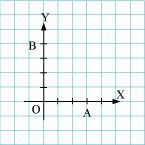
In the above figure, O is the origin, A is a point at a distance of 3 units on x-axis, and B is a point at a distance of 4 units on y-axis.
Can we find the distance between the two points A and B?
In coordinate geometry, the distance formula has a lot of applications. Let us look at one of its applications.
What can you say about the three points (–6, 10), (–1, 1), and (3, –8)? Are they collinear?
Let us see.
If the sum of the distances of any point from the other two is equal to the distance between the other two points, then we can say that the given points are collinear.
For example, let (–6, 10), (–1, 1), and (3, –8) be denoted by A, B, and C respectively.
Now, using distance formula, , we obtain
, we obtain
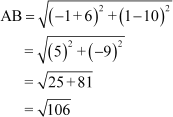
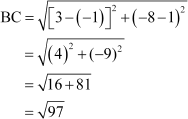
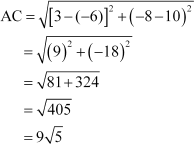
Here, AB + BC
≠ AC
Therefore, the points A, B, and C are not collinear.
Let us solve some more examples based on the distance formula.
Example 1: Find the distance between the point (7, –1) and origin.
Solution:
Let the points (7, –1) and origin (0, 0) be denoted by A and O respectively. Then, using distance formula, we obtain
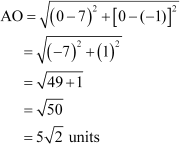
Thus, the distance between the points (7, –1) and (0, 0) is  units.
units.
Example 2: Find the value of a, if the distance between (a, –1) and (8, 3) is  .
.
Solution:
Let points (a, –1) and (8, 3) be denoted by A and B respectively. Then, using distance formula, we obtain

The distance is given as . Therefore, we can write
. Therefore, we can write

On squaring both sides, we obtain
16 × 5 = 64 + a2 – 16a + 16
⇒ 80 – 64 – 16 = a2 – 16a
⇒ 80 – 80 = a2 – 16a
⇒ a2 – 16a = 0
⇒ a (a – 16) = 0
∴ a = 0 and 16
Thus, the values of a are 0 and 16.
Example 3: Find the point on y-axis that is equidistant from (–5, 2) and (9, –2).
Solution:
The x-coordinate of all points on the y-axis is zero. Therefore, let (0, b) be the point which is equidistant from (–5, 2) and (9, –2).
∴ Distance between (0, b) and (–5, 2) = Distance between (0, b) and (9, –2) Using distance formula, we obtain

On squaring both sides, we obtain
29 + b2 – 4b = 85 + b2 + 4b
⇒ 8b = 29 – 85
⇒ 8b = –56
⇒ b = –7
Thus, the point (0, –7) on the y-axisis equidistant from (–5, 2) and (9, –2).
Example 4: Check whether the points (–3, –2), (–2, 3), and (3, 4) are the vertices of an isosceles triangle or not.
Solution:
Let the vertices (–3, –2), (–2, 3), and (3, 4) be denoted as A, B, and C respectively as shown in the figure.
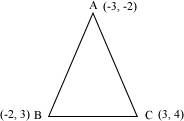
Using distance formula, we obtain
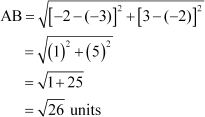
BC

AC

Now, AB = BC =  units
units
Thus, (–3, –2), (–2, 3), and (3, 4) are the vertices of an isosceles triangle.

 SonikaAnandAcademy
SonikaAnandAcademy
 ACERISE INDIA
ACERISE INDIA
